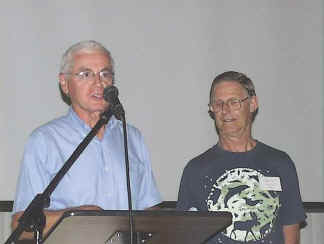
Volume 42 Number 5
ASA/CSCA 2000 on the Ocean
Almost two hundred attendees met Aug. 4-7 at Gordon C. in Wenham, MA, near the New England coast and a few miles south of ASA's headquarters in Ipswich. Richard Wright (ASA) and Harry Cook (CSCA) put together a full and diverse program of plenary speakers; paper sessions; poster sessions; education workshops; symposia; a panel discussion; a special presentation; worship of God; a clam bake; affiliation, commission, and local area meetings; and time for the core activity of ASA meetings: informal discussion.

Richard Wright (l) and Harry Cook (r), ASA/CSCA 2000 program chairmen
The well-run meeting (thanks to Gordon physicist Jerry McNatt, local arrangements chairman) focused on the oceans, which (as the meeting theme proclaimed) bore witness to the greatness and wonder of God's works. On Friday, Aug 4, about 110 attendees got to within one-hundred feet of humpback whales. The gargantuan animals seemed accustomed to human visitation. The whale-watchers were tutored on whale behavior as they engaged in the growing business of whale watching.
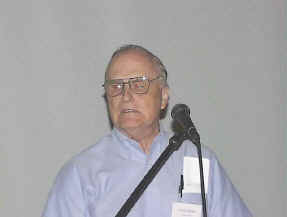
Jerry McNatt, ASA/CSCA00 arrangements chairman
Plenary Speakers Describe Their Work
The other business, whale hunting, was described by plenary speaker, Ray Gambell of Great Britain, where he is secretary of the International Whaling Commission and a zoologist heading the Institute of Oceanographic Sciences.
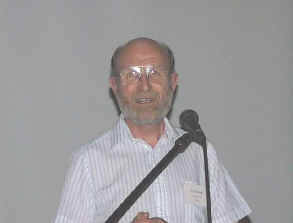
Ray Gambell, who heads the International Whaling Commission, spoke on whales and whale hunting.
Early in the twentieth century, fin, sei, and Minks' whales were hunted, in order of size, to near extinction. Blue whales were nearly depleted in the 1930s, and today, of the large whales, only Minks' and gray whales are not endangered.
Fortunately, whaling is now off limits in the Indian Ocean and elsewhere in the southern seas, as the number of nations observing a moratorium on whaling is increasing. Whales feed in colder waters, especially near Antarctica, and migrate to warmer waters to give birth. They efficiently convert small shrimp (krill) to oil, stored in blubber. Ray had a picture of a sperm whale born moments before in the Indian Ocean.
Today Japan and Norway are the major whaling nations. They honor catch limits based on whale species size relative to the blue whale.
Ray noted the importance of truthfulness in the science that sets policy in the whaling commission. His leadership has set an example of honesty with facts that has done much to maintain the trust needed for agreements to be accepted and honored. In a couple of months, he will be retiring from the Commission.
The second plenary speaker on Saturday evening was Susan Drake Emmerich, a Christian anthropologist, who became involved in Tangier Island, a closed island subculture. Tangier Island is located in the Chesapeake Bay with a population of about eight hundred people. Susan spoke of the way in which she was able to become accepted by the Tangier fishing community.
The watermen would indiscriminately pollute the bay with trash and oil. Susan convinced them to enter into a covenant to preserve the bay by changing their waste disposal habits. She did this by appealing to their already-established beliefs, connecting in their minds their faith in Jesus, their Pilot on the water, with their caring for his creation. She lived on Tangier Island for longer than the two years that most outsiders previously had been able to persist.
In publishing about the experience, she cautioned about generalizing from the Tangier Island case, though her approach has succeeded elsewhere in the world. Susan attributed her success in reaching the islanders (where others had failed) to a faith-based approach, appealing to the core beliefs of the islanders in conveying to them an ethic of care for God's creation.
Reports on some "Marine" Sessions
In the first of several "marine" sessions, physical oceanographer David Chapman of Woods Hole described how Arctic Ocean circulation is poorly understood, despite its crucial role in the global climate. This is because it is difficult to work there. The Arctic Ocean is as deep as any other (4000 m), and its three- meter polar ice cover helps to maintain desirable temperatures at lower latitudes. At 150 to 250 meters deep is a layer of cold, salty water called the arctic halocline. Without it, the warmer (-2 ƒC), saltier water beneath it would melt the ice cover. Through the Bering Strait, which is only 60 m deep, a high inflow of water (1 Mm3/s) exits around Greenland.
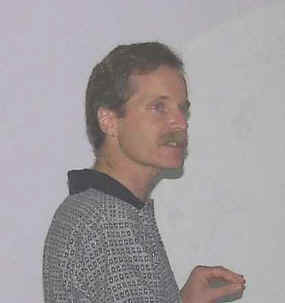
David Chapman spoke on Arctic Ocean circulation.
Open surface water, called polynyas, supply the halocline layer. Wind over the polynyas form ice, the salt drops out, and sinks into denser water. How denser water moves offshore has been Chapman's research topic. Instead of simply sinking to the halocline layer, the earth's rotation produces a Coriolis force on current flows, causing them to rotate. Circular flows along the shore create eddies that move dense water offshore, producing tongues of turbulent movement, as David's computer- animated simulations displayed.
Henry Hengeveld is the senior science advisor on climate change for Environment Canada. He recounted that the oceans cover 70% of the earth's surface and hold 95% of carbon active in the global carbon cycle. They play a dual role in weather variability, as the "bass" (slower-responding) accompaniment to the "treble" atmosphere. Several graphs of data showed the downward trend of the extent of ice, probably not a long-term oscillation.
The thickness of arctic sea ice has decreased 40% over forty years and El NiÒo/La NiÒa activity has been increasing recently. The 1998 measured temperature was the highest in the last one thousand years and atmospheric CO2 concentration has been increasing over the last 8,000 years. Climate models are based on weather forecast models. The model is fitted to the climate data of the last one hundred years, and is run into the future. The prediction: 1.5 to 4.5 ƒC warming by 2100. Temperature trends are not simple because warming is not uniform. Warming occurs more over land and the polar regions, the ocean circulation and sea ice is reduced, and precipitation is increased. With warming comes thermal expansion. By 2100 they predict a rise in the sea-level of 15 to 45 cm.
Engineer Steve Hall of Louisiana State U. addressed the sustainability of aquaculture ("sea farming"). It is not easy to replicate the wonders of the oceanic creation. It takes much energy to pump air into warm water to oxygenate it, driving prices up. Catfish prices have halved due to international competition. However, fish are more efficient in "protein transformation" than chickens, and are a very good source of food.
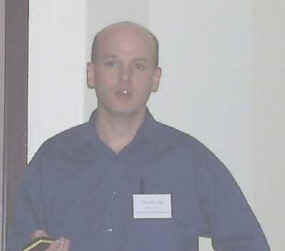
Aquaculture engineer Steve Hall
Another aquacultural activity is to gather alligator and turtle eggs in the wild, raise them, and return 14% of the gators. Both gator and turtle populations are increasing in the wild where this is being done. Steve ended his talk by referring to the "river of life" in Revelation, and the biblical concepts of abad and shamar in Gen. 2:15.
Gordon College's own Dan Lindstrom has been studying some very odd fish that live in tropical streams with steep waterfalls in Hawaii, Indonesia, and the Philippines. These amphidromous fish (which do not move to spawn) spend their youth in seawater and most of their adult life in fresh water. Dan's pictures showed the large "suction pad" fin under the fish's chin that enables it to climb waterfalls. Lentipes concolor is one of five species in Hawaii, there called "hinana."

Dan Lindstrom of Grodon College is studying colorful tropical fish that climb waterfalls in Hawaii.
With the aid of native children, Dan discovered and caught samples of these colorful and flamboyantly-finned fish in flood sewers beneath houses in Asia, including the very house he was in when he asked where he might find them! The natives quickly warmed up to Dan once he showed them pictures of the kind of fish he was seeking.
… in 323 A.D. Christianity had thrived for nearly three and a half centuries before getting entangled with political forces and letting lust for status detract from its love for truth. Now that science has thrived for about the same length of time, cracks in its edifice have begun to show up--often for the same reason. --Walter Hearn, Radix, Jan/Feb 2000, p. 9.
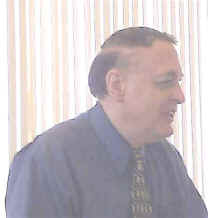
Don Munro at ASA/CSCA00
By the time you receive this letter ASA/CSCA 2000 will be history and some forty-five of us will have traveled around Nova Scotia, Prince Edward Island, and New Brunswick, Canada. As of this writing there are over 190 registered for the meeting and we hope for a few additional registrants to get us over 200. Co-program chairs, Dick Wright and Harry Cook, and our local arrangement's chair, Jerry McNatt, have carefully planned the meeting. Carol Aiken spent many, many hours putting everything in place. We cannot give any of these people enough thanks. Future Corners may contain other things from the Council meeting and ASA/CSCA 2000.
What a joy it was to do some ASA database sleuthing and find that there are at least twenty-nine active ASAers who have been members of ASA for fifty years or more. Alton Everest is the granddaddy of us all having started in 1941. Unfortunately, some of this is sketchy because as many of you know our records were lost in the Illinois fire. However, I have discovered that the earliest journals have membership lists and also tell us when new members joined. Thus, I am slowly checking this out and placing the correct dates in our database.
This year we are able to celebrate fifty years or more of membership for four who will be attending ASA/ CSCA 2000: Wilbur Bullock, James Buswell, Paul Mauer, and Jack Veyhinger. Congratulations to these members who are to receive a framed certificate to commemorate it.
Now we begin to turn our attention to ASA 2001 at Kansas State U., July 20-23. Watch for a call for papers from Joseph Sheldon, the Program Chair. Keith and Ruth Miller, the Local Arrangements Co-chairs, have already reserved meeting rooms in what will be the newly decorated Kansas State Union. On Fri. afternoon, July 20, there will be a tour of the Konza Prairie project and a bison herd visit. For dinner we will eat buffalo burgers at the Konza Prairie Headquarters. After dinner, David Harnett, current director of the Konza Prairie, will address us. You will not want to miss that nor our two plenary speakers, Sir Ghillean Prance and Wes Jackson. On Mon. afternoon, July 23, we are considering some interesting local field trips. Let us know if you have suggestions for the meeting.
The latest Templeton/ASA Lecture Series talks are winding down in Sept. (See PSCF [Sept. 2000]: 189). To date forty-one lectures have been completed with generally good attendance. For the first time, a head of state attended one of the lectures. David Foster, a biologist at Messiah C., spoke on the topic, Christianity and the Ethics of Modern Science at the U. of the West Indies in Belize City on March 15, 2000. The Right Honorable Prime Minister of Belize, Said Musa, presented introductory remarks and introduced Foster. The Prime Minister made clear his long-term interest in the relationship between science and religion. He said:
As people of faith, the people of Belize care deeply about God and His precepts. It is of the utmost importance that we take the best of what science can offer and incorporate it with our faith in God and commitment to develop the country with the future in mind.
The lecture was sponsored locally by the Global Stewardship Study Program (GSSP) at Jaguar Creek, Belize. Chris Elisara, GSSP's executive director, was a Templeton Science and Religion Course Award winner in 1998. A week later, Steven Bouma-Prediger of Hope C. spoke there on the topic, Finding Home: Religion and Science in a Postmodern Age. These were the first lectures in this series outside of Canada and the U.S.
Soon you will receive the new ASA/CSCA 2000-2003 Membership Directory, if you ordered one with your dues. This is a book for members only. In it you will find a new member- approved, revised copy of ASA's Constitution and Bylaws. It also gives you contact people for ASA and CSCA as well as a listing of future meetings and area representatives for Canada and the United States.
There is an alphabetical listing of members followed by a geographical listing. At the end, the membership of the three affiliations and the eight commissions is listed. I hope that you will be able to use this to make contact with others in your area or field for the continued work of bringing science and religion together. If you failed to order one or would like a second copy, the Membership Directory can be ordered from the ASA for $5.00 plus p/h.
We are on the financial home stretch for 2000. I hope that God is reminding and preparing you for a generous gift in the final quarter of this year. As I have often said, the ongoing work of the ASA depends heavily on you. I hope that it is also your desire to complete the two-for-one matching grant for the endowment.
Last but by far not least, please pray for the ASA and CSCA staff, the leaders of the affiliations and commissions, and the ASA Fellows, who are being asked to embark toward some new directions.
I pray that you will have a good start to the fall season in whatever you may be doing.
CEST Sessions Highlight Technology and Society
Besides the Meeting's theme sessions, the ASA/CSCA 2000 symposia were on the history and philosophy of science (see p. 8), and on technology. ASA's newly formed affiliation, Christian Engineers and Scientists in Technology or CEST, is headed by Ruth Douglas Miller, an electrical engineering prof. at Kansas State U. in Manhattan, KS. Microwave engineer John Osepchuk, the vice-president of CEST, and Ruth have both studied the human health effects of electric and magnetic fields, with involvement in the IEEE's Committee on Man and Radiation (COMAR).
Opening the first CEST session, Ruth narrowed the radiation of interest to that with enough energy to break atomic bonds--that with a frequency greater than infrared radiation. But her talk was about the social dimension of this technical group, COMAR, in making decisions on a controversial issue, paralleling plenary speaker Ray Gambell's whaling commission involvement. As a committee member herself, Ruth observed that professionalism motivates COMAR members. That means, in part, that money is not everything. Personal integrity is highly valued, members have confidence in their expertise, science is very important, and admission of ignorance (to say "I don't know") is okay.
An issue the committee addressed was whether 60 Hertz fields affect human health. Factors motivating this question by COMAR members included concern for health (especially for children), truth, personal success, research funding, and industry economics. COMAR is evenly divided (5 to 5) on the question. The biologists tended to think electromagnetic fields are harmful and that the engineers and physicists do not understand, while complementary views tended to be held by them.
Randy Isaac was in a good position to give his talk on trends in semiconductor technology, as a vice-president of science and technology at IBM. In 1965, one of the pioneers of integrated circuit (IC) technology published Moore's Law: that the density of computer memory circuitry (RAM) would double every year.
Moore's Law was an accurate prediction until the early '70s, when the rate decreased to a doubling every eighteen months. The curve has hit another rate decrease, as the physical limits of the technology are approached. As transistor (MOSFET) geometry shrinks, gate thickness becomes so small that quantum tunneling effects appear. ICs have been wired with aluminum, but copper, a better electrical conductor, is now being used. However improvements beyond copper - using the best conductors, gold or silver - are marginal.
Randy described where the rapid advancement of computing/communications technology is leading. In the next five years, wireless data rates will increase to accommodate video streaming. As computing power increases, some measurements of it will be approaching those of the human brain, estimated at 1014 to 1016 flops/s (10,000 terraflops/s). (A "flop" is a floating-point arithmetic operation. A terraflop is 1000 gigaflops, or 1000 billion flops.)
Bill Joy of Sun Microsystems, a leading workstation-class computer maker, has recently warned of the potential danger of self-replicating, mutating, evolving cybernetic agents. Randy reminded us of the Christian responsibility to integrate technology and faith, focus on positive applications, and minimize negative uses of technology.
Technology and its application in the Kosovo war is close to David Condron's Washington, DC work experience. Following sociologist James G. Wilson, David posited that we are not innately good but are potentially good. A moral sense entails sympathy, fairness, self-control, and duty. These qualities are learned in the family setting, the universal morality school. David described foreign policy with moral goals: promotion of global markets, women's rights, long-term national (U.S.) commitment, and contributions to international order.
Jack Swearengen of CEST, an engineering dept. head at the U. of WA in Vancouver, continued the "Technology for Morality" thread. People have become more afraid, insecure, and alone, and civility has declined. Jack related how technology addresses these trends by providing levels of assurance: protection, security, surety, and safety.
How Many Stars in the Milky Way?
by Fred Hickernell, ASA Arizona Coordinator
"How many stars in the Milky Way?" That's the "anticipatory set" my teacher-wife, Thresa, advised as we escaped from the 105ƒ heat of the Arizona desert to the cool pines of Flagstaff. It was also the title of a talk we were soon to hear from our ASA member-host, Harry Guetter, at the United States Naval Observatory in Flagstaff (USNOFS). It was an invitation given for a June 10 Saturday gathering, of Arizona ASA members at the observatory followed by a potluck picnic in the backyard of Harry and Jopie Guetter. We relished the escape from the desert, but more important was the anticipated fellowship with other ASA members.
Arizona is one of the centers of star gazing in the United States, with the mountain peaks surrounding the Tucson area in the south and the famous Lowell Observatory and USNOFS near Flagstaff in the north. These locations offer the best, darkest, and clearest skies for placing telescopes. The Naval observatory has four telescopes, the largest a 1.5 meter reflector, which is used for optical and infrared astronomy. After Harry's illustrated talk on astronomy in general and the observatory's mission in particular, we went up to the huge dome. It housed the 1.5 meter telescope and the nerve center controlling the dome and telescope position with its TV monitors which display the heavens as detected by sensitive charge-coupled arrays.
Our group of twelve was dazzled by the displays of the heavens as Harry brought up images on the monitors recorded by the telescope. The star clusters, nebulae, and galaxies all reminded us that "the heavens declare the glory of God." As we stepped out onto the catwalk outside the dome and viewed the surrounding forest and mountains, our senses were quickened to the fact that, "the firmament declares His handiwork."
Down from the mountain-top experience to the city of Flagstaff and backyard of Harry and Jopie, we ate and fellowshipped as brothers and sisters in Christ. There was no lack of things to talk about. The evening was cool enough to put on sweaters.
"How many stars in the Milky Way?" We couldn't pin Harry down to an exact number. "We are still counting, and the new infrared detector will allow us to see cooler dying embers of stars and newly discovered, nearby L- and T-dwarfs which we cannot see in the optical spectrum," was Harry's answer. Harry has been counting since 1964, and he may have his biggest count still ahead of him.
Kansas Evolution Report
by Ruth Douglas Miller, Electrical and Computer Engineering, Kansas State U.; rdmiller@eece.ksu.edu http://www.eece.ksu.edu/~rdmiller/home.html
Kansas has been a very busy place in matters of faith and science this spring semester 2000. I report here on two items: (1) the visit of Kevin Padian, vertebrate paleontologist at U.C. Berkeley, to Kansas State U. (KSU) and the U. of Kansas (KU); and (2) the AAAS-sponsored conference at KU called "Science, Teaching and the Search for Origins."
All the activity locally has provided us plenty of opportunity to state our strong commitments to the Creator God of the universe and to sound science--to scientists and others of all sorts of faith backgrounds.
As president of the KSU chapter of Sigma Xi, I invited Padian last spring to come as our spring 2000 visiting lecturer. At the time I was thinking of attracting guests with a talk on dinosaurs, but by the time he came his position as president of the National Center for Science Education was far more important. I took the liberty of inviting all the church folks I could think of to attend Padian's public discussion of the evidence for evolution and the importance of teaching this basic theory of biology in the public school classroom.
To all of us: students, faculty, and public school teachers, Padian stressed that "special creationism" in any form is not a scientific theory and does not belong in the science classroom.
The week after Padian's visit, Keith, Ian, and I drove down-river to KU for the AAAS conference. Organized primarily for public school teachers throughout the state, this weekend conference featured plenary talks by several speakers. Interspersed were discussion breakout sessions for the general public and for educators; Keith led the discussion in geology for the teachers. All the speakers were unanimous in their declaration that science is only one way of knowing and is definitely not inherently atheistic or founded upon philosophical naturalism.
Ken Miller opened the conference as keynote speaker. As his biology text is used in science classrooms in the Lawrence school district, his presentation was of great interest locally. Some ASAers may remember him from his talk at the 1995 annual meeting at Montreat, NC. He is as entertaining a speaker as he is a writer, and his presentation mostly followed the text of his book, Finding Darwin's God. He presented the evidences for transitional forms in the fossil record as well as scenarios for the evolution of such "irreducibly complex" structures and pathways as eyes, flagella, the Krebs cycle, and the blood-clotting cascade. He stressed that more and more publications are appearing on the evolution of existing elaborate biochemical pathways from simpler but still functional precursors.
Ursula Goodenough, author of The Sacred Depths of Nature, spoke on the various types of genetic mutation and how these provide mechanisms for the assembly of complex biochemical and cellular systems. She also stressed the limitations of scientific inquiry: it is important to recognize that many of the deepest and most significant human questions lie outside of science.
Peebles, who was involved in the discovery and analysis of the cosmic background radiation and works on the very early history of the universe, spoke on the current understanding of the Big Bang.
Robert Pennock closed the conference with a talk based on his book, Tower of Babel, in which he uses the evolution of language as a parallel but perhaps less emotional subject to biological evolution. In observing that many critics of evolution equate the idea that humans share a common ancestor with great apes with "humans are not created by God," Pennock stressed that "evolution is godless the same way plumbing is godless!" He also put in a plug for David Livingstone's book, Darwin's Forgotten Defenders, mentioning B. B. Warfield along with the popes who accepted biological evolution as a scientific description of God's creation.
What's New in Print
… Darwinist critic and UC Berkeley law prof. Phillip Johnson has written another book, The Wedge of Truth, published by IVP. To order by phone call: (800) 843-9487. Or, for a discount (and to help ASA, too), order via the ASA web site (www.asa3.org) by clicking on Barnes & Noble.
Here is a sampling of what the new book contains:
In the final analysis, it is not any specific scientific evidence that convinces me that Darwinism is a pseudoscience that will collapse once it becomes possible for critics to get a fair hearing. It is the way the Darwinists argue their case that makes it apparent that they are afraid to encounter the best arguments against their theory. A real science does not employ propaganda and legal barriers to prevent relevant questions from being asked, nor does it rely upon enforcing rules of reasoning that allow no alternative to the official story. If the Darwinists had a good case to make, they would welcome the critics to an academic forum for open debate, and they would want to confront the best critical arguments rather than to caricature them as straw men. Instead they have chosen to rely upon the dishonorable methods of power politics (p. 141).
… George
Murphy has published an article, "Science Education
and Religion-Science Conversations," in the July issue of Physics
& Society, the newsletter of the American Physical
Society's Forum on Physics and Society. The e-version is
available from the homepage for the forum:
www. physics.wm.edu/~sher/fps/fpshome.html
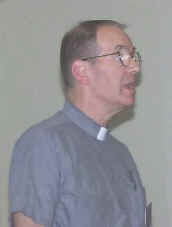
George Murphy, speaking at ASA/CSCA00
George says: "I took advantage of discussions about science education in the wake of the Kansas decision to encourage science-theology dialogue." He is presently a pastoral associate at St. Paul's Episcopal Church in Akron, Ohio.
Food for Thought: Reaching Student Minds Using Pizza
Mathematician and U. of Chicago grad student Karl-Dieter Crisman describes an idea for engaging students on wider issues: pizza seminars! The math department sponsors the weekly pizza (provided by the math department) seminar so that math graduate students can lecture on topics of interest to all math grad students and not only to those in their field.
On smaller campuses, Karl says, this would also work, because undergrads would mostly know one another and could get everyone in a given class to come along.
In one pizza seminar, the goal was to get grad students through both the intuition and math of Bill Dembski's book on the inference of design. Karl reports that it went just fine, most understood it quite well, and asked very insightful questions. Karl noted that one question that did not come up was, of course, what we hope the inference of intelligent design will eventually be applied to - but he suspects it was in everyone's minds. The pizza seminar, however, accomplished the modest goal of opening minds to design. Karl adds:
I encourage those of you who can explicate the math in it [The Design Inference] to present it in little informal seminars like this. The basic idea is so clear, so one can then give the audience as much math as they can handle so they are convinced it is rigorous (and it sure is). If you offer free pizza, of course, this helps for attendance.
Karl also writes:
You might want to be aware of a technique a friend of mine is using to get people to go to a talk (as far as I know not design-related); simply cancel class and have them attend the talk! Write a paragraph summary for the next class period. If you make it "instead" rather than "and," the incentive to go is greater.
Is ID "Punctuated Naturalism"?
Howard Van Till has been arguing for an origins viewpoint in which God creates a universe capable of unfolding into its present complexity without the need for him to intervene at times. This view tends to be viewed as conflicting with Intelligent Design (ID), which has a reputation for implied interventionism. Recently, Howard made the following comments regarding the two views:
The crusaders for ID are correct to point out that the preachers of evolutionary naturalism (as a comprehensive world view) need to be answered. ID's answer is to attack the scientific concept of evolution and replace it with a theory of extra-natural assembly. I consider this cure to be no better than the disease. The problem is not with current scientific theorizing, it is with the scientism and leaps of illogic that propagandists like Richard Dawkins and Daniel Dennett spit out in the name of science.
One way to describe ID's problem is that it seems to be a program shaped primarily by its function as a reaction to the rhetorical excesses of today's preachers of ontological naturalism. As such, it generally accepts the fundamental ground rule of naturalism: if atoms, molecules, cells, organisms and ecosystems have the formational capabilities to accomplish the remarkable organizational and transformational feats that evolutionary biology proposes, then a Creator-God is no longer needed. In essence, the ID response is to propose a "punctuated naturalism," that is, a formational history of the universe in which naturalistic processes (often characterized as unguided, purposeless, materialistic, etc.) are occasionally punctuated by episodes of intelligent design (form-imposing acts performed by some unidentified extra-natural agent).
My proposal is that Christians ought to lead with a card from their strong suit: the historic Christian doctrine of creation. Whatever the universe is and is capable of doing must be seen as a "gift of being" from the Creator. In the context of seeing the universe as a creation, every one of its resources, potentialities, and capabilities can then be experienced as a manifestation of the Creator's creativity and generosity. Instead of looking for evidence of gifts withheld (that is, looking for things that the creation is unable to do) Christians can celebrate every formational capability that the sciences uncover.
The essence of God's creative action is not in occasional form-imposing interventions, but in the giving of being to a creation fully capable of accomplishing the Creator's intentions for its formational history. Where is there evidence of God's creative activity? Everywhere!
The creation issue in ASA continues to be not over the claim that God created but over how. Perhaps the issue is unresolvable, unless God chooses to subject his agency to human rational scrutiny. We are called biblically to exercise dominion, not only physically but also intellectually, over the creation, which is the historical role of science. Has "science" gone beyond its biblical mandate so that it now entails an implicit materialism, or has it not gone far enough in discovering and comprehending physical clues from the past that might otherwise reveal more fully the formational capabilities endowed it by its Creator - or both?
Philosopher Koons on Web
Another downloadable info-banquet on the Web is from philosopher of science Rob Koons. Rob has posted his lectures on theism at the U. of Texas. He covers three major topics: the cosmological argument, the argument from design, and the problem of evil. The web address is: www.dla.utexas. edu/phl356/
Rob is hoping to put together a book based on these lectures, and feedback, both negative and positive, is welcomed. His address is: Rob Koons, Associate Professor, Department of Philosophy, University of Texas at Austin, Austin, TX 78712-1180; (512) 471-5530; fax: (512) 471-4806; web: www.dla.utexas.edu/depts/philosophy/ faculty/koons
Theologian Speaks
As a fellowship of Christians in science, ASA integrates both the spiritual and scientific dimensions of life. This is evident at ASA meetings, where science presentations and worship of God are blended into a harmonious whole.
John (Jack) Jefferson Davis of Gordon-Conwell Theological Seminary spoke at ASA/CSCA 2000 on Isa. 40:25-31 of "God of creation, God of our circumstances." Isaiah turns our attention to the God of creation. John's exposition included two points. First, the doctrine of creation is found not only in the familiar Gen. text but also in Isaiah, Jeremiah, Daniel, Ps. 104, Job, Proverbs, John 1, Col. 1, and Heb. 1, where Christ the Son is presented as co-creator with God the Father. Secondly, the doctrine of creation is not only about origins but also about relationships. Jack elaborated along the line of a creation stewardship ethic.
For the setting of the Isaiah text, Israelites were confronted in Babylon by the power of its gods, Marduk and Ishtar. When God says through Isaiah, "To whom will you compare me?" these gods would have come to mind.
Jack presented three alternative views of nature: mythological and magical, scientific, and theological. Natural theology precedes the Christian church and is found in Aristotle, and later Augustine, and in William Paley's Bridgewater Treatises. It diminished under the influence of philosophers Immanuel Kant and David Hume in the nineteenth century, but is again flourishing, with new design arguments.
Jack went on to describe fine-tuning of the cosmos, as found in Hugh Ross, Paul Davies, and Bob Newman. Princeton astronomer Robert Dicke discovered that the fundamental physical constants affecting cosmological models are fine-tuned. For instance, the Big Bang is tuned to a probability of 10-60, which is like hitting a nickel at the edge of the universe with a gun. Gravity is fine-tuned to 10-40; an exceedingly miniscule difference in the strength of gravity would have resulted in a different kind of universe than exists. Over 100 instances of fine-tuning have been found since 1960.
Isaiah 25, 26 invites us to look at the heavens from a theological perspective. Isaiah (v 27) infers also that the God of this creation is also the God of personal circumstances, and that "Only one who is eternal can create in any ultimate sense."
What ASAers Do
… Steve Lee of Schaumberg, IL is starting his academic life on a tenure track at Roosevelt U., teaching courses in organic chemistry.
… Past ASA president and journal editor, Richard Bube, won a 1999 Exemplary Prize in the Templeton Foundation's "Expanding Humanity's Vision of God" essay contest.
… Bob Pease, a member of Grace Cathedral (Episcopal) in San Francisco, wrote a book to help young drivers avoid car accidents, titled How To Drive Into ACCIDENTS--And How NOT To. It shows many examples of how to avoid car accidents, and focuses on seemingly harmless errors that can lead to serious trouble when you (or your teenage children!) aren't expecting it. (For further information about this book, see: www. transtronix.com or order from: Pease Publishing, 682 Miramar Ave, San Francisco, CA 94112; $21.95/copy.)
But this report is about what Pease has been doing really far from any freeways. Bob is ordinarily an electronics engineer at National Semiconductor Corp. in Silicon Valley, but he has been trekking in the Himalayas in Nepal, packing with him such items as a GPS position locator, a foot-operated generator, and a one-pound solar panel to recharge batteries. Bob comments:
I am not sure how many ASAers go to Nepal. Many Christians do go there, and most of us get along with the Buddhists and Hindus pretty well. We don't have to agree much with their religion--I am not a big fan of Hinduism--but they are mostly very nice people!
Many scientists, engineers, and technical guys also go there, for hiking, Bob notes. Have any other ASAers been hiking or climbing amongst the big peaks? Bob has initiated past hiking parties, and those hoping to get away for some vigorous exercise can look at the photos on Bob's web site: www.national.com/rap/nepal/gallery.html
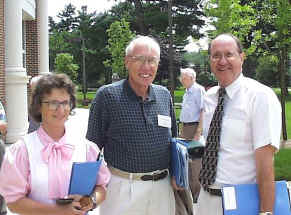
ASA/CSCA 2000 (l to r): Dottie Feucht, Sture Bengtson, Jack McIntyre (background), and Dick Leo.
ASA/CSCA 2000 Covers Philosophy and History of Science
ASA is blessed with many first-rate historians of science. Previous ASA Executive Director Robert Herrmann chaired a session led off by Harvard astronomer-turned-historian of science, Owen Gingerich, a scholar of the Galileo affair. Owen deflated the overblown view, due in part to Thomas Kuhn's influential work, The Structure of Scientific Revolutions, of the Copernican "revolution." He showed that books with little Ptolemaic circles of the planets were still in vogue well after Copernicus and Tycho Brahe advanced their ideas and findings.
The heliocentric idea took some time to catch on, and Owen's own efforts of searching old observatories, such as one in Scotland, uncovered primary data showing the resilience of the older theory. In scientific style, the scientists of Galileo's day were reluctant to quickly abandon the established theory of the heavens. It was not until Galileo's use of the telescope--then a new technology--which revealed the occultation of Venus, that the new theory had the substantial empirical support it needed to make Ptolemy's theory obsolete.
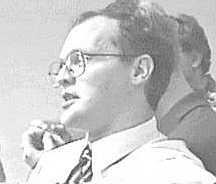
Science historian Ted Davis at ASA99
Other ASA historians' talks covered nineteenth- and twentieth-century science in Britain and America, and were given by Ted Davis, Jack Haas, Mark Kalthoff, and Sara Miles. They are available on audiotape (along with the other ASA/CSCA 2000 presentations) for $4 each from the Sanders Christian Foundation, P.O. Box 2094, S. Hamilton, MA 01982; (978) 468-7306; tapesharer@aol.com
Tapes of ID Critics' Conference Available
The audio tapes for the recent conference, Design and Its Critics (see May/Jun 2000 ASAN, p. 6), are available (product #C010) from: Access Research Network; tel. 888-259-7102. The cyberspace ordering address is: www.arn.org/orders/audios/c010.htm
The cost is $99 for a three-volume, 24-tape set, plus $5 for priority shipping. ARN also offers each eight- tape volume separately for $39.95. Check the ARN web site (www.arn.org) for which speakers are on which tapes, and also for a program guide to go along with the cassettes (listing the talks and speakers' backgrounds). * Dennis Wagner
Welcome, New Members! June-July 2000
Arendt, Cassandra -Chicago, IL
Baik, Seong yul -La Crescenta, CA
Bordelon Alder, Donna -Rochester, NY
Boyce, Sheri -Grantham, PA
Curry, Janel -Grand Rapids, MI
Duncan, Robert -Towson, MD
Elder, Eric -Atlanta, GA
Geiger, Kristin -Randolf, NJ
Kennelly, Timothy -Ballston Lake, NY
Kim, Daniel -Downey, CA
Koetje, David -Grand Rapids, MI
McLaren, J. Philip -Quincy, MA
Melton, Jon -Grantham, PA
Moritz, Joshua -Nazareth, PA
Nekrasov, Vladimir -Bishkek, Kyrgyzstan
Park, Damoi -Newport Coast, CA
Rhoads, David -Winfield, IL
Schultz, Mike -Edmonton, AB Canada
Secker, Heather -Wheaton, IL
Smith, Chad -Bakersfield, CA
Tice, Michael -San Jose, CA
Witt, Kathryn -Grantham, PA